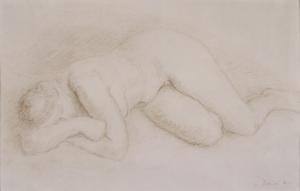Charles Despiau (1874 - 1946)
Charles Despiau, who was born in Mont-de-Marsan on the fourth of September 1874, issued from a family of plasterers. In 1891, at the age of seventeen, he settled in Paris to study at the Ecole des Arts Décoratifs and take a stone-cutting apprenticeship. Three years later, he entered the Ecole des Beaux-Arts. At that time, he admired Rodin’s work but wasn’t influenced by it however.
From 1898, he was a regular participant in the Salon des Artistes Français, where he exhibited figures and busts, but he quit it in order to join the Société Nationale des Beaux-Arts, which he found younger in spirit. The works he showed drew the attention of Claude Roger-Marx, an art critic, and of Georges Werner, a friend of Rodin who was also an important member of the Beaux-Arts ministry. In 1901, Despiau joined in the group of independent sculptors and became a member of the “bande à Schnegg”. In 1907, Rodin, who had seen many of his works and was confident with his talent, employed him in his studio.
Despiau was drafted into the army from 1914 to 1919. In the years that followed the war, he endured severe financial problems but managed to regain a steady income, thanks to his friends André Derain, Maurice Wlaminck and André Dunoyer de Segonzac. At that time, Despiau worked under contract for the Barbazanges Gallery. Paulette’s Bust (1907), The Faun (1912), the Mont-de-Marsan war memorial (1920-1922), Eve (1925) and Assia (1937) were the major works he achieved throughout his career. His growing fame won him upper class clients who commissioned him numerous busts, including the portraits of Mrs Boisdeffre (1920), Mrs Zunz (1921), Miss Marie-Zéline Faure, also called Zizou (1924)…
In 1923, he took a part in the founding of the Salon des Tuileries, along with Bourdelle, Maillol and some of the members of the “bande à Schnegg”. He also joined in the Salon d’Automne exhibition, and started teaching at the Grande Chaumière. In 1927, the Brummer Gallery in New York hosted his first personal exhibition abroad, and he was appointed teacher at the Scandinavian Academy. His works then travelled from Brussels to Chicago, The Hague or London. In 1937, the Petit Palais held an exhibition entitled Masters of Independent art, which included fifty-two sculptures by Despiau. A Despiau-Wlérick Museum was founded in Mont-de-Marsan in 1968....
From 1898, he was a regular participant in the Salon des Artistes Français, where he exhibited figures and busts, but he quit it in order to join the Société Nationale des Beaux-Arts, which he found younger in spirit. The works he showed drew the attention of Claude Roger-Marx, an art critic, and of Georges Werner, a friend of Rodin who was also an important member of the Beaux-Arts ministry. In 1901, Despiau joined in the group of independent sculptors and became a member of the “bande à Schnegg”. In 1907, Rodin, who had seen many of his works and was confident with his talent, employed him in his studio.
Despiau was drafted into the army from 1914 to 1919. In the years that followed the war, he endured severe financial problems but managed to regain a steady income, thanks to his friends André Derain, Maurice Wlaminck and André Dunoyer de Segonzac. At that time, Despiau worked under contract for the Barbazanges Gallery. Paulette’s Bust (1907), The Faun (1912), the Mont-de-Marsan war memorial (1920-1922), Eve (1925) and Assia (1937) were the major works he achieved throughout his career. His growing fame won him upper class clients who commissioned him numerous busts, including the portraits of Mrs Boisdeffre (1920), Mrs Zunz (1921), Miss Marie-Zéline Faure, also called Zizou (1924)…
In 1923, he took a part in the founding of the Salon des Tuileries, along with Bourdelle, Maillol and some of the members of the “bande à Schnegg”. He also joined in the Salon d’Automne exhibition, and started teaching at the Grande Chaumière. In 1927, the Brummer Gallery in New York hosted his first personal exhibition abroad, and he was appointed teacher at the Scandinavian Academy. His works then travelled from Brussels to Chicago, The Hague or London. In 1937, the Petit Palais held an exhibition entitled Masters of Independent art, which included fifty-two sculptures by Despiau. A Despiau-Wlérick Museum was founded in Mont-de-Marsan in 1968.









